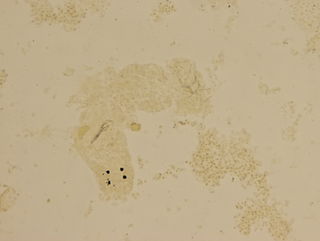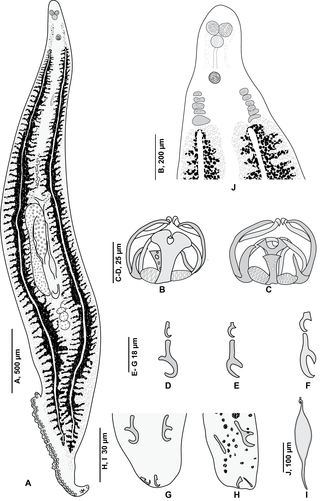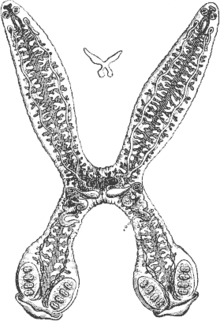Dactylogyrus is a genus of monogeneans in the Dactylogyridae family.

Dactylogyrus vastator is a species of monoic flatworms of class Monogenea. It is an ectoparasite of fish which infests the gills. It is problematic on fish farms. It is otherwise non-hazardous to humans.

Polyopisthocotylea is a subclass of parasitic flatworms in the class Monogenea.

Microcotyle is a genus which belongs to the phylum Platyhelminthes and class Monogenea. Species of Microcotyle are ectoparasites that affect their host by attaching themselves as larvae on the gills of the fish and grow into adult stage. This larval stage is called oncomiracidium, and is characterized as free swimming and ciliated.

The Monopisthocotylea are a subclass of parasitic flatworms in the class Monogenea.
Lethacotyle is a genus of polyopisthocotylean monogeneans, included in the family Protomicrocotylidae.
The genus includes only two species: Lethacotyle fijiensisManter & Price, 1953 , the type-species of the genus, and Lethacotyle veraJustine, Rahmouni, Gey, Schoelinck, & Hoberg, 2013 . Both species are parasitic on the gills of jacks in the Pacific Ocean. They are known only from three localities: off Fiji, Andaman Islands, and New Caledonia.
The genus Lethacotyle is special in that its members have no clamps on their posterior attachment organ or haptor, in contrast to most polyopisthocotylean Monogenean which have clamps. This is reflected in the etymology of the name, which, according to Manter & Price is "from letha = forgetting, and cotyle = cup, and refers to the absence of clamps".
Discocotyle sagittata is a species of freshwater monogenean gill ectoparasites of Salmo and Oncorhynchus. Their lifestyle is characterised by a free-living larval stage that may be inhaled by a suitable freshwater fish host, after which they may attach upon expulsion over the gill onto a single gill filament. Upon reaching maturity, parasites can remain attached by a posterior opisthaptor with its 8 associated clamps. Adults may reach a few millimetres in length. D. sagittata feeds on the blood of the gills via an anterior mouth part. Adults are hermaphrodite, and produce 3–14 eggs per day at 13 °C, a process which is temperature dependent. Once produced, eggs drop to the riverbed surface and at 13 °C take 28 days to develop to hatching larval forms. Major parasite burden can result in damage to the host gill and anaemia from blood loss.

The haptor is the attachment organ of the monogeneans, a group of parasitic Platyhelminthes. The haptor is sometimes called opisthaptor to emphasize that it is located in the posterior part of the body, and to differentiate it from the prohaptor, a structure including glands located at the anterior part of the body. According to Yamaguti (1963), the chief adhesive organ of the monogeneans, the haptor, is posterior, more or less discoid, muscular, may be divided into alveoli or loculi, is usually provided with anchors, has nearly always marginal larval hooklets, or is in a reduced form with anchors. The haptor may consist of symmetrical or asymmetrical, sessile or pedunculate, muscular suckers or clamps with or without supporting sclerites; accessory adhesive organs may be present in form of armed plaques, lappets or appendices.

Pseudorhabdosynochus is a genus of monopisthocotylean monogeneans, included in the family Diplectanidae. The type-species of the genus is Pseudorhabdosynochus epinepheli .

Lagenivaginopseudobenedenia is a genus of monopisthocotylean monogenean, included in the family Capsalidae. The type-species of the genus is Lagenivaginopseudobenedenia etelisYamaguti, 1966. The genus includes only 2 species, which are both parasitic on the gills of marine fish of the family Lutjanidae.
Alexandr Vladimirovich Gussev, sometimes spelled Gusev in the literature, was a Russian helminthologist specialist of monogeneans.
Calydiscoides is a genus of monopisthocotylean monogeneans, included in the family Diplectanidae.
Gyrodactylus turnbulli is an ectoparasite from the class Monogenea, is part of the phylum Platyhelminthes, and from the genus Gyrodactylus. It only requires one host to transmit an infection; however, since this parasite lacks oncomiracidium, it must rely on either the adult or subadult for spread of infection. Found in freshwater, this flatworm is commonly found on the gills and fins of the guppy, Poecilia reticulata. G. turnbulli was said to be host specific, but an experiment where parasitologists artificially infected guppies suggests that the parasite can infect a wider range of species. This ability is achievable by host switching, which promotes speciation.
Gyrodactylus leptorhynchi is a small monogenean obligate ectoparasite which parasitizes freshwater bay pipefish. Gyrodactylus leptorhynchi is the seventh Gyrodactylus species known to infect bay pipefish and the first characterized along the Pacific coast of North America. The parasite can get into captive fish environments, such as fish farms and aquariums, where it may spread in as little as 10 days. Gyrodactylus species are known to centralize on the brood pouch in male fish, this may allow for transmission to newly hatched young. However, in Gyrodactylus leptorhynchi the parasite was found mostly found attached to body surfaces such as the dorsal fins.
Diclidophora nezumiae is a species of monogenean flatworm that parasitizes the gills of the rattail fish Nezumia bairdii. Due to a highly localized host habitat parasite incidence is relatedly localized to the Hudson Submarine Canyon.

Microcotyle sebastis is a species of monogenean, parasitic on the gills of a marine fish. It belongs to the family Microcotylidae.

Pseudaxine is a genus which belongs to the phylum Platyhelminthes and class Monogenea; all its species are parasites of fish.

Pseudaxine trachuri is a species of monogenean, parasitic on the gills of a marine fish. It belongs to the family Gastrocotylidae.

Sibitrema poonui is a species of monogenean flatworm, which is parasitic on the gills of a marine fish. It belongs to the family Gastrocotylidae.

Allopseudaxine macrova is a species of monogenean flatworm, which is parasitic on the gills of a marine fish. It belongs to the family Axinidae.














